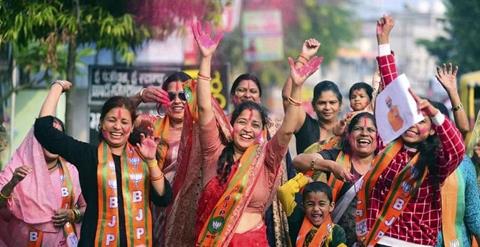2023 Elections: A Prelude to India’s 2024 Political Landscape
Following the election, Odisha Chief Minister Naveen Patnaik called Prime Minister Modi to offer congratulations, which raises concerns about both national politics and regional dynamics.
In a political landscape often marred by uncertainty, the recent assembly elections in five Indian states have emerged as a decisive precursor to the General Election 2024. Dubbed the “Semi-Final” of the upcoming national elections, these state elections have delivered a striking outcome. All victorious parties achieved an absolute majority, starkly contrasting the fragmented results in 2018.
have emerged as a decisive precursor to the General Election 2024. Dubbed the “Semi-Final” of the upcoming national elections, these state elections have delivered a striking outcome. All victorious parties achieved an absolute majority, starkly contrasting the fragmented results in 2018.
Decisive Mandates and Voter Sentiments
The clarity of these mandates is a response to the political instability in states like Maharashtra, Bihar, Madhya Pradesh, and Rajasthan. In these regions, previous elections resulted in hung assemblies or governance that did not command an absolute majority. This shift suggests potential voter fatigue with the prevailing ‘aya ram gaya ram’ politics – a colloquial term for political defection and instability.
An examination of 16 state assembly elections held between 2022 and 2023, including the recent five, shows a similar trend of decisive victories. Out of these, 13 states have witnessed governments with absolute majorities. Interestingly, the ruling parties have increased their representation even in states with lesser national political weight, like Goa, Nagaland, and Meghalaya. This pattern marks a significant departure from the nearly three decades of unstable governance witnessed in many Indian states.
Emerging Trends and Voter Maturity
The question arises: what drives this trend towards stable, majority governments? The answer might lie in the evolving maturity of the Indian electorate. After the unstable central governance period starting in 1989, voters chose a stable government with an absolute majority in the 2014 general elections. This trend continued into the 2019 elections, highlighting a preference for stability and governance over political turbulence.
The results from the five states in question are particularly intriguing. Two national parties of opposing ideological poles and a regional party with no clear ideological stance have emerged victorious. This outcome suggests that voters are possibly less concerned with party ideologies and more focused on performance and welfare schemes.
Media Introspection and The Hindu
Amidst these political shifts, the role of media in shaping and reflecting public opinion cannot be understated. A notable instance is the tweet from Malini Parthasarathy, a renowned journalist and former editor of The Hindu, known for its critical stance towards the BJP-led government. Parthasarathy’s tweet acknowledged the charisma of Prime Minister Narendra Modi and the BJP’s focus on welfare and development, critiquing the Congress party’s negative campaign approach.
This acknowledgement from a figure associated with a traditionally critical publication signals a significant shift in media perception. It reflects an increasing awareness of the changing political landscape and voter aspirations.
Divisive Politics and the North-South Divide
The election results also reignited discussions on regional divides, particularly the North-South divide in Indian politics. A controversial tweet by Praveen Chakravarty, Chairman of the Congress Party’s Data Analytic department, highlighted this divide but was promptly deleted following backlash. This episode underscores the sensitivities surrounding regionalism in Indian politics and the potential pitfalls of exploiting these divides.
Congress spokesperson Tehseen Poonawalla’s warning against indulging in North-South rhetoric reflects a broader concern within the party about alienating sections of the electorate. Similarly, C.R. Kesavan’s tweet criticizing the Congress party’s divisive tactics points to the growing discontent with such strategies.
Naveen Patnaik’s Role and Future Implications
The congratulatory call from Odisha Chief Minister Naveen Patnaik to PM Modi post-election raises questions about regional dynamics and national politics. Patnaik’s gesture, seen as rare in the current political climate, suggests a nuanced approach towards cooperative federalism.
These state election results offer critical insights as India inches closer to the 2024 General Elections. They reflect the electorate’s preference for stable, decisive governance and underscore the country’s evolving political narrative. With the possibility of a weakened opposition and the electorate’s growing aversion to divisive politics, the upcoming national elections might further consolidate these trends.
The “Semi-Final” of the 2024 General Elections has set a definitive tone for what lies ahead. It’s a narrative of political stability, voter maturity, and a decisive shift from traditional party politics to a more performance-based evaluation. This election serves as a precursor for the major electoral battle in 2024, hinting at an increasingly pragmatic, development-oriented political landscape that reflects a ‘New India’ aspiration.
